Tactical Data Engagement
A guiding framework for data providers, inside and outside of City Hall, to investigate and catalyze community use of information and open data.
Preface
Since the beginning of the What Works Cities initiative, Sunlight’s Open Cities team has helped over 60 U.S. cities enact open data policies and has tracked and analyzed open data policies in over 100 cities, counties, and states. We’ve come a long way in helping cities establish strong foundations for openness through open data policies, transparency initiatives, and open data portals. Writ large, Sunlight’s efforts have effectively bolstered the infrastructure for democratic access to government data in cities across the nation.
But, while a number of local governments have done a good job publishing large amounts of data, many have little to no idea who is actually using it. Businesses? Academic researchers? App developers? Policy advocates? Different users have different needs — and by figuring out who these users are, what they want, and why they want it, governments can reach out to specific users in the community and provide the right data to help current and potential data users achieve impactful goals.
Tactical Data Engagement is designed to help government staff and other community data providers to catalyze open data’s use for meaningful problem-solving by going beyond publishing open data policies and portals.
We believe that local governments in particular must go beyond publishing open data because we fundamentally believe that information is power and that all residents have a democratic right not only to access information but to use it. Our vision is that city halls and other governments will use Tactical Data Engagement to catalyze action in communities with the highest need for access to government and public information. In particular, we hope city leaders will use this framework to identify and reach out to disenfranchised community members with real information needs, and make a concerted effort to support those communities in using public information for local action. We believe that if all local governments took an intentional, equity-based approach to open data, they could bring real access to power and decision-making to marginalized communities that often go overlooked as audiences for civic technology, open data, and transparency.
Community use of open data is, at its core, about radically valuing residents’ needs as well as the outcomes governments and residents can achieve together when residents are placed at the center of tech and data innovation. We believe in the idea that people are experts in their own lives, and have woven explicit commitments to human-centered design into this guide. This guide encourages readers to ask: What can governments do to actively facilitate opportunities for open data use in communities? Where are information gaps that governments might help to close? And how can government become an equal partner with residents in leveraging open data for community impact?
We hope this guide helps communities everywhere answer those questions.
Introduction
Learn about how we built Tactical Data Engagement, and how to use this guide as a hands-on resource.
What is Tactical Data Engagement?
Tactical Data Engagement (TDE) is a four-step framework designed for local government staff develop a resident-centered culture of open data (in the long-term) and generate buy-in for resident-centered open data through tactical, meaningful wins for the community (in the short-term).
We created this framework based on the core concepts of human-centered design and tactical urbanism, with steps that guide city officials toward carrying out an intervention that facilitates the community use of open data for local impact. This approach goes beyond basic resident engagement. It seeks to make open data programs more holistically resident-centered by challenging city halls to first understand and then act to help residents use open data.
We hope readers will use this framework as a hands-on guide by following the steps of TDE, or as a tool for communicating what’s possible with resident-centered open data.
We built this guide to be adaptable.
We acknowledge that every city, town, place, or neighborhood is different. So rather than creating restrictive rules for how to carry out each step of the process, we point to expertise in the fields of user-centered design, design research, civic tech, and others to point out which adaptable, incremental, and inexpensive tactics are already out there. The most important thing is that at every step, readers challenge themselves to consider how residents can be more directly incorporated to decision-making and experimentation with open data for community problem-solving.
Who should use Tactical Data Engagement?
This guide was originally designed for city officials and other public servants who want to work with community actors to get more value out of open data and information. But anyone who is a data provider, or who needs to begin segmenting and investigating opportunities for community use of open data can use the strategies we outline here.
This guide can help you scope out which problems are appropriate for open data solutions. It can help you research and segment the current and potential users of your open data. It can help you co-design and work alongside key stakeholders to plan a real community-informed solution. And it can help you enter into collaborative community partnerships with concrete intentions around who you’re aiming to support, what you can provide, and why your collaboration is important.
If you work for a city government with an open data program already in place, TDE can help you take that program to the next level by building on your policy or portal. TDE can also help city halls that are just starting out with open data begin sharing the right data with the right people, and begin demonstrating what open data success can look like.
If you are an advocate, researcher, librarian, or organizer who wants to incorporate the use of open data into your existing work with communities — or seek out opportunities to partner with governments in facilitating the community use of open data — TDE has a lot to offer you as well.
No matter where your community is in its open data work, we hope you enjoy reading about the TDE method, and are able to put these tactics to work!
The Framework
Tactical Data Engagement can help data providers complete tactical, lightweight projects while building toward long-term human-centered open data practice.
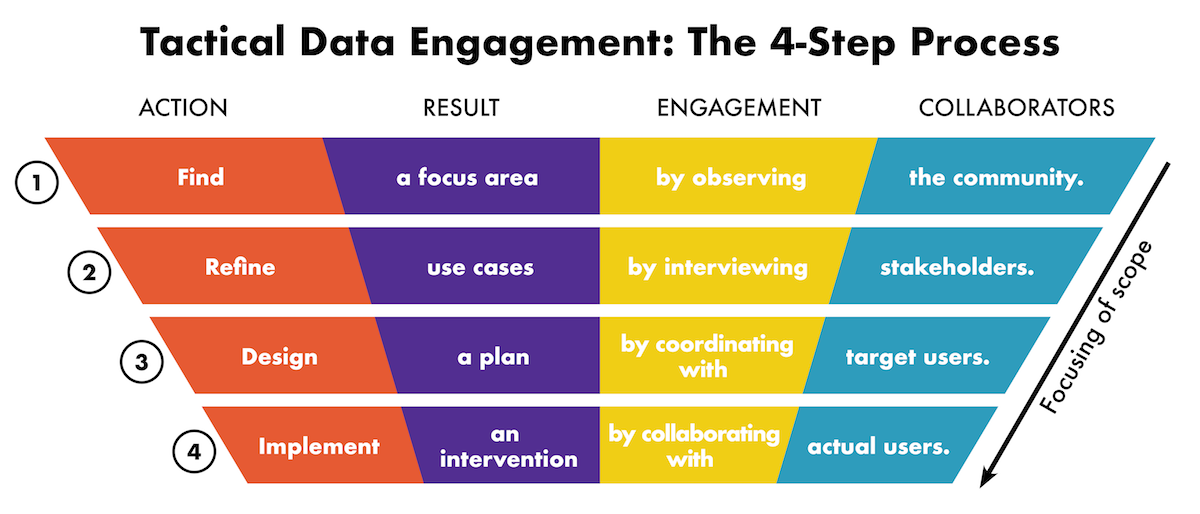
In this guide, we lay out a sequence for Tactical Data Engagement that starts with broad problem scoping and ends with supporting a tactical, lightweight, specific opportunity for community use of open data. This framework is perfect for testing out principles of human-centered open data and demonstrating value through resident-centered stories of impact.
While Tactical Data Engagement is laid out as a step-by-step process, it is also a modular, adaptable collection of resources that any data providers can use to build human-centered practice into their open data efforts. Government staff can benefit from training data owners in this framework’s modular strategies, with or without completing a beginning-to-end Tactical Data Engagement pilot project.
Different phases, different goals
We’re calling the first two steps of Tactical Data Engagement, Find and Refine, the Discovery steps because data providers should spend the front end of any Tactical Data Engagement project framing, scoping, and researching the problems they’d like to tackle. As we explain later in A Modular Approach, these steps are meant to help city government staff and data providers build a culture of doing problem-scoping and design research based on communities’ information needs. Understanding the strategies we use to complete the Discovery steps can help data providers share more community-centered open data even if they’re not completing the entire Tactical Data Engagement process.
The last two steps of Tactical Data Engagement, Design and Implement, are what we call Action steps. In developing the guidance for these steps, we leaned heavily on existing practices of co-creation, co-design, design thinking, and community partnerships. Cities and data providers can use the strategies in these steps to take tangible action to improve the accessibility and impact of their open data. However, in the chronology of Tactical Data Engagement, we put these steps after Discovery because we believe that while you can co-create and partner with community organizations to develop solutions using open data, it’s important to approach action intentionally.
A final note: This process is meant to be repeated, or iterated, so that it can be applied to new opportunities for communities to use open data. Over time and various iterations, Tactical Data Engagement can help local leaders develop a more open culture and consistently facilitate a community’s use of open data with varying members of the community and across various opportunities.
Step 1: Find
The first step in TDE is listening to analyzing community demand signals for transparency, open data, or even policy change, and identifying the issue areas where open data might help.
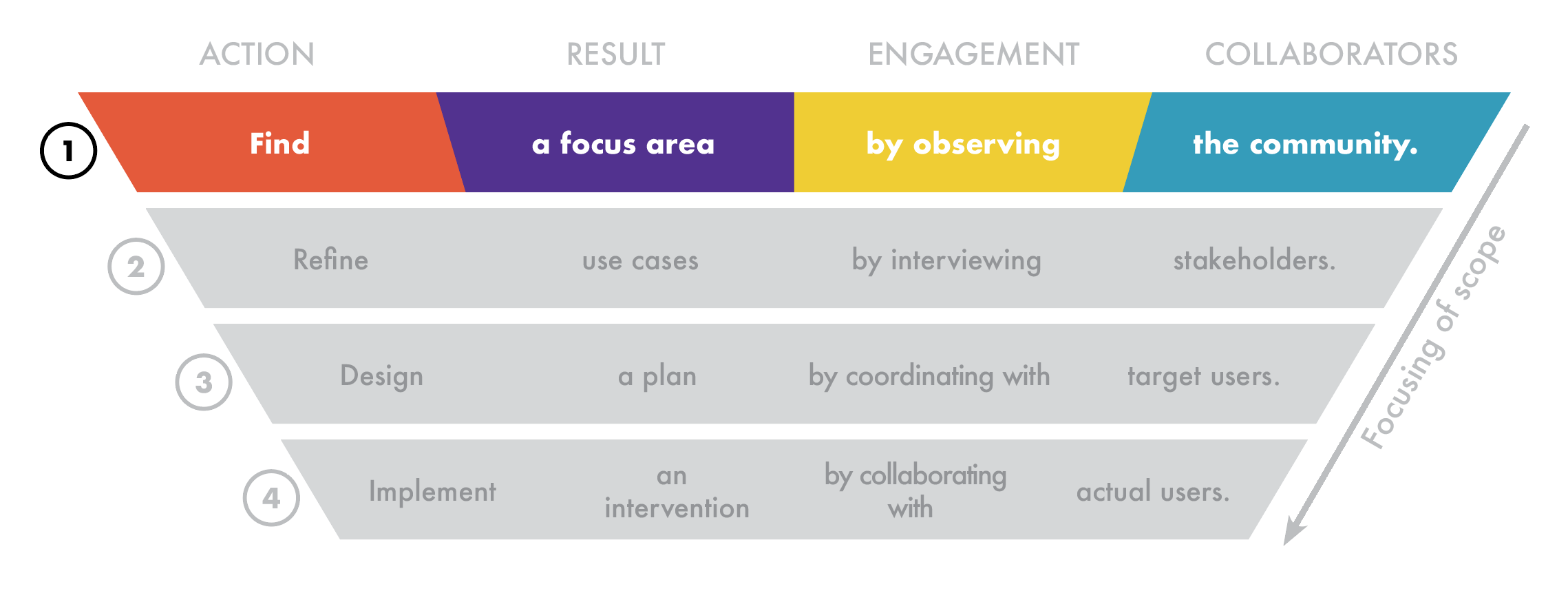
☑ Evaluate your internal priorities for open data
☑ Listen to community demands for public data and info
☑ Identify which priorities overlap
☑ Choose to proceed with a clear focus area
You may already be listening to residents’ concerns and needs by conducting surveys, maintaining relationships with trusted community groups, or regularly joining community meetings. Use each opportunity you have to collect and analyze broad community interest in open data.
As you listen to and observe the community’s needs, identify opportunities where public data or information would empower residents to better understand, address, or collaborate to solve their concerns. Observe whether a majority of promising opportunities for the use of open data are clustered around a single issue or focus area.
The result: A clear focus area
After listening to a variety of challenges that might require the community use of open data, choose a focus area by aligning those opportunities with the city’s on-going strategic priorities as well as with the cities information holdings.
Step 2: Refine
In this step, look within your focus area for open data use cases by investigating who community members are, what open data and information they need, and why they need it.
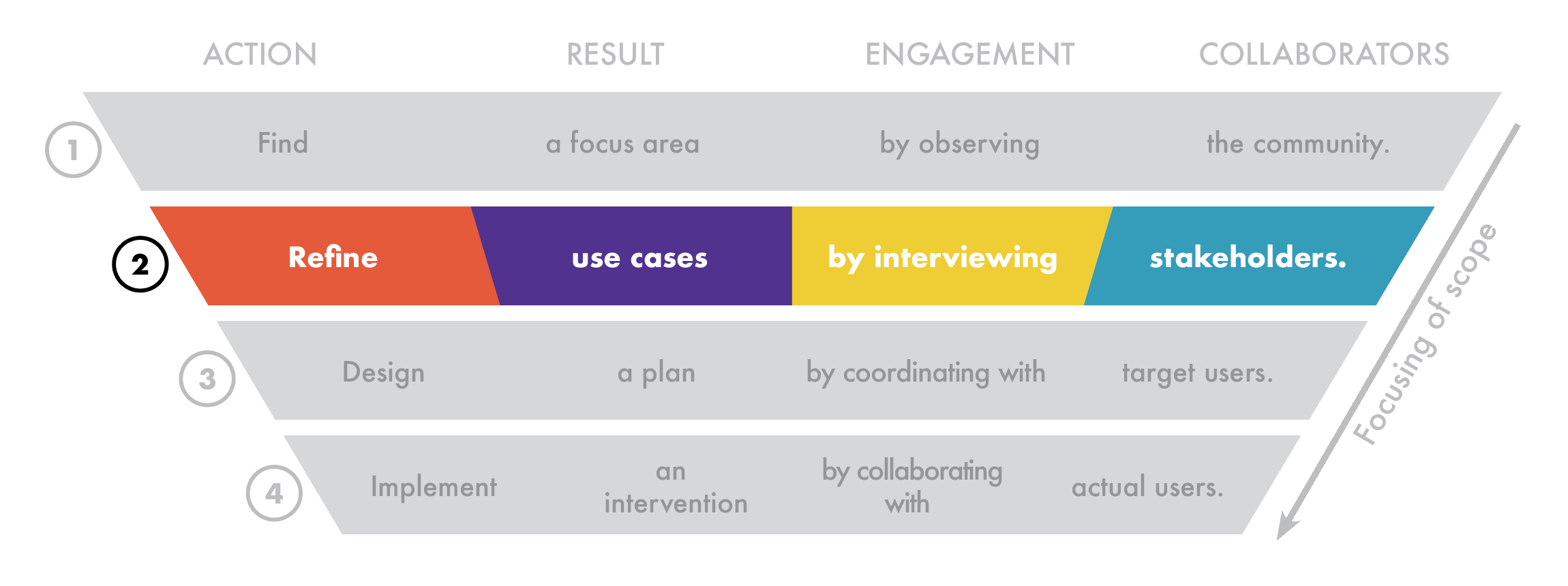
☑ Narrow down stakeholder groups relevant to your focus area
☑ Do interviews, focus groups, surveys, or research (optional)
☑ Segment specific user types and use cases for open data
☑ Begin prioritizing community use cases for you to support
☑ Avoid getting ahead in planning how you'll support use cases
As you dive deeper into your focus area, you’ll be looking to gather as much information as you can about who needs open data or public information, what they need, and why they need it. No matter what strategies you use to begin answering these questions, you should ensure that you’re reaching out to community members to ground-truth your understanding of residents’ needs for information and data. Remember that residents are experts in their own neighborhoods, communities, and issue areas, and listening to their knowledge will help refine the details around specific use cases for open data in your focus area.
In this step, we challenge data providers to think creatively about how data and information play a role in the lives of their residents.
What is data? Try to think expansively about what “data” means. To you, data might be a structured .csv file with accompanying metadata. To potential data users, it might be a single statistic they need to write an informed news article, a data visualization that helps them understand their neighborhood’s health, or a map of City-run community centers so that they can navigate available social services.
In conversations with community stakeholders, investigators should listen for clues about who people with data needs are, what data or information they regularly use or are seeking, and why they need that public data. Investigators should also closely document and synthesize these findings into clear use cases.
Strategies to complete this step can be found in the Discovery section of Sunlight’s Roadmap to Informed Communities, including guidance on how to write a good use case.
The result: A set of use cases and relevant personas
We find that looking at a set of five to seven use cases for open data can help city staff take a “big picture” look at the community’s data needs and the City’s priorities to evaluate which use cases might align well with ongoing or potential city efforts.
Use cases can be fleshed out and humanized through the development of user personas. Taking on the additional effort to develop user personas may seem frivolous at first, but often helps teams align around a vision for who in the community will benefit from their open data efforts. In essence, personas are stereotypes, constructed intentionally and with anonymized community input. While they are not comprehensive in capturing all of residents’ needs across the board, with enough focus on data and information, they can give data providers a helpful short-hand when planning their programs.
Multiple user types as laid out through personas may share use cases with other users, or have multiple use cases for open data. This is an imperfect process. Regardless, documenting the who, what, and why components of a use case, and taking extra time to flesh out the who through user personas can help build strong foundations of issue-oriented community-centered design into your open data program.
Step 3: Design
In this step, ask how you can support identified use cases and map out potential solutions by feasibility and potential impact alongside community stakeholders.
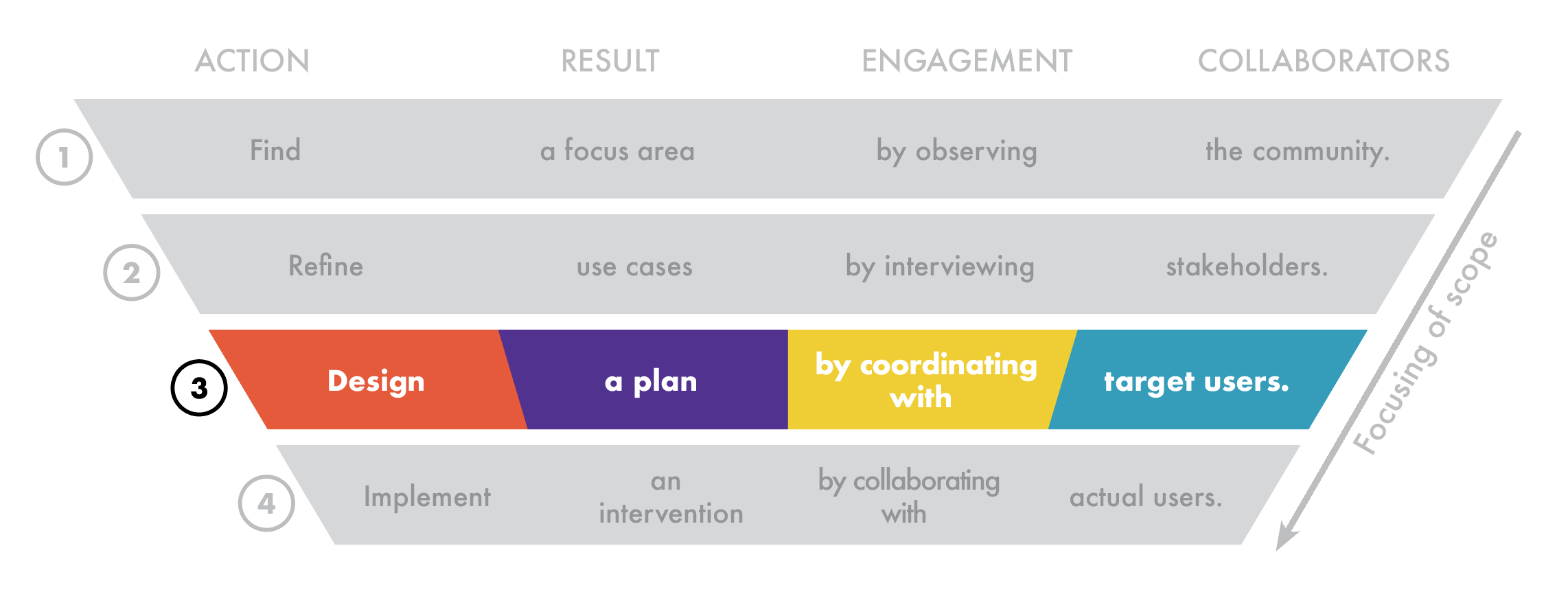
☑ Propose creative open data solutions to support use cases
☑ Rank use cases and potential solutions by feasibility & impact
☑ Choose one or two potential use cases & solutions to support
☑ Convene relevant stakeholders to re-imagine solutions
☑ Scope and plan to implement co-created solutions
Designing data-driven solutions based on community needs must be an iterative and open-minded process. It’s important to note that choosing to support a use case and beginning to brainstorm solutions should be a process that engages external stakeholders at every opportunity possible.
Up until this point, research has focused on broadening data providers’ understanding of community needs. In this step, readers should narrow in a specific use case and begin co-designing tactical, implementable solutions. Limiting opportunities in this step to support only one use case is crucial for taking a tactical, focused approach to facilitating the community use of open data, one iteration at a time.
For practical reasons, at this stage, data providers and internal stakeholders often need to convene internally to assess which use cases identified in the Discovery steps are relevant to internal strategic priorities. All of the identified use cases should have clear roots in community needs, so moving forward, data providers may choose to support one potentially feasible, impactful use case. For example, cities with nascent open data programs may choose to support low-hanging fruit use cases where the community’s needs are centered around data accessibility and usability. Cities with mature open data programs may choose to support harder-to-solve use cases, maybe pertaining to complex social issues and requiring hands-on community partnerships or technical development.
Narrowing the focus and choosing to support a specific use case opens the door for data providers to convene people who are specifically relevant to the problem at hand to begin co-designing solutions. Data providers should first narrow down the intended users of relevant data and then decide how to work more closely with them to begin mapping potential interventions like products, projects, or tools. This is the point at which data providers and community members alike can convene to ask: “How might we better support this clear use case for open data?”
The result: A co-designed project plan
Collaborative planning with the intended data users in your community is essential for ensuring that planned interventions address exactly what data users need and account for details of implementation, for example, ensuring that the community agrees on who should house the project or sustain it once the government’s role is complete. A plan that hasn’t been reviewed by residents is less likely to be effective.
Whether the tactical solution you eventually come to is a new tool, a civic hacking event, a website, a reformatted dataset, or a how-to guide, data owners should document and share out input with project partners. Closing feedback loops between data owners and their community partners helps build trust between participants in the open data ecosystem and furthers good open government practice.
Step 4: Implement
This step is where you help actual users, identified through previous research and co-design, to carry out the planned intervention that addresses your community-approved open data use case.
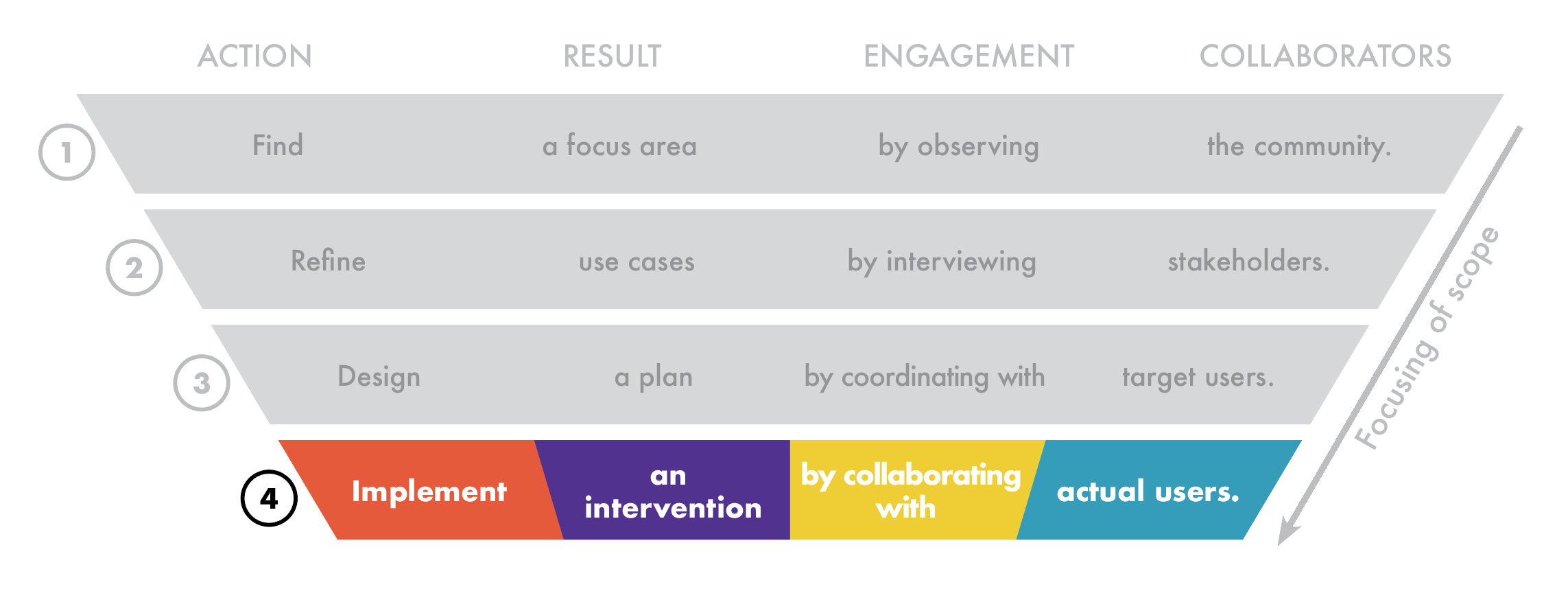
Carrying out this intervention is the culmination of facilitating community use of open data. We developed the tactics in this section based on interventions that data providers and cities have used to facilitate community use of open data through projects, tools, or products. The opportunity to facilitate data use may mean sharing datasets that are not currently available in formats and with contents that best suit the needs of the requesters.
Commit to consistent or open feedback channels with residents to ensure you met needs and are driving toward impact. If your project will be delayed, communicate with community stakeholders about why. Note that the first solution may not always be the best one, and that those members of the community who contributed to the project — and who are the primary users or beneficiaries of community improvements through the use of open data — have crucial insight into any product’s usability.
An important piece of building community trust in public data and public institutions is following through on commitments and maintaining open lines of communication.
The result: Demonstrated success
Completing a tactical, community-informed project by using this process can demonstrate to stakeholders inside and outside of your organization that open data has clear applications in addressing pertinent social issues. As data providers continually work with community members to apply open data, they can incrementally increase their maturity and take on harder, more impactful social issues.
In our work, we’ve found that community members, no matter their core issues, no matter their role in the city, can always benefit from better information in some shape or form. Sometimes that information comes in the form of open data. With this framework, we hope that cities will expand the role that open data plays in improving residents’ and empowering them to take action.
A Modular Approach
Even without using the step-by-step guide to Tactical Data Engagement, the strategies at the center of this approach matter.
Open data needs a focus to be effective
Data with an unclear focus will have unclear impact. Data providers inside and outside of city governments should consider which issues their data will help to address before they decide to share and promote engagement with that data. Part of sharing human-centered open data at a city level means ensuring that open data is not only tied to a specific issue, but that that issue is relevant in supporting the local community.
For example, cities should not publish data on transit just because the data exists, but also because community members have indicated that they want the city to improve transit and provide more transparency around transit-related issues. Data providers can leverage problem scoping strategies like the ones that we’ve built into Step 1: Find to ensure that open data sets or projects are grounded in issues that communities care about.
Cities should invest in understanding data users
In private industries, customer segmentation and market research are essential for businesses to understand and meet their clients’ needs. If local governments want to be more effective in fighting pressing local challenges, they need to invest in design research to understand and document their stakeholders’ needs. We think that focusing in on residents’ data and information needs provides a helpful framing that can ground this research in actionable opportunities for impact.
Unlike in private industries, local governments have a democratic responsibility to provide equal opportunity and access to public data and services for all residents. Segmenting current and potential data users can not only help local governments build stronger understanding of their constituencies but can also help them focus in on supporting potential data users with the highest need. Data providers can leverage user-centered design strategies like the ones we outlined in Step 2: Refine to start building a thorough understanding of their residents’ data and information needs.
Residents want a say in how public data and tech are applied
The public should always have an opportunity to contribute to the decision-making behind technology and data projects that will ultimately affect them. In general, inviting stakeholder participation in project design can help improve the effectiveness of the end product in meeting stakeholders’ needs. Specifically, local governments have a responsibility to open their decision-making to local residents when it comes to experimentation and innovation using public data and technology.
Data providers must incorporate resident input, either through user testing, survey efforts, or hands-on co-creation, into the open data pilot projects to ensure that end products of open data projects will actually meet stakeholders’ needs. By designing with members of their communities, local government staff can also work to ensure that their data and tech projects are designed by inclusive, diverse teams. Data providers and local government staff alike can use co-creation strategies like the ones we outline in Step 3: Design to begin engaging their residents to design effective products.
Institutions need to pony up for community partnerships
Without concrete commitments to community partnerships and collaboration, open data projects between data providers and users may lack sustainability and real impact. Different types of projects to open up or apply public data require different levels of commitment on the part of data providers or local governments. Tactical Data Engagement provides an opportunity for local governments to reconsider exactly how they partner with their constituencies across the board, and may encourage them to think outside the box when it comes to taking a hands-on, human-centered approach to fostering community problem-solving and innovation with tech and data.
Data providers can use the strategies and tools we provide in Step 4: Implement to better evaluate their own capacity to be true partners with their local data users. Governments in particular should be aware that data and tech-driven community collaborations will deteriorate without formalized commitments to institutional support.

